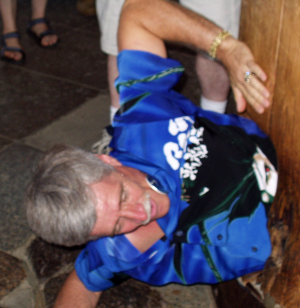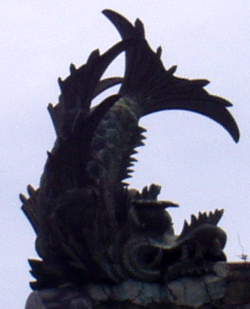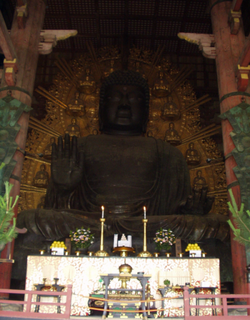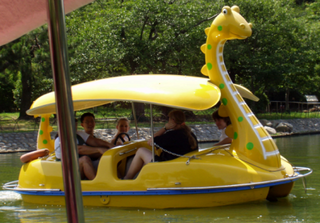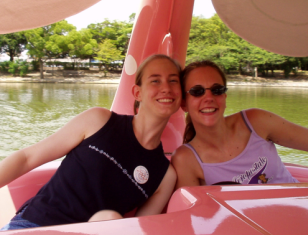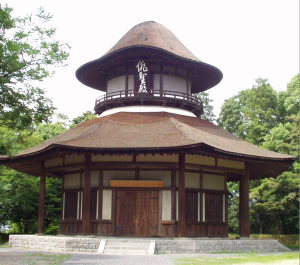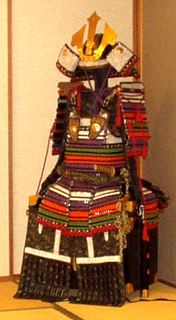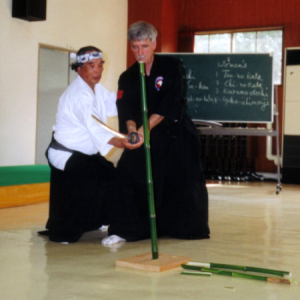American-Japanese Goodwill Tour 2002
AMERICAN-JAPANESE GOODWILL TOUR 2002

The American Iaido Team with Head Master Matsuno &
Grand Master Crandall at the base of Himeji Castle
In July of 2002, the American-Japanese Goodwill tour and American Iaido Team, under the directions of Grand Master Clifford C. Crandall, Jr., visited Japan to exchange knowledge and develop good international relationships. Good international relations are everyone's responsibility. The fertile top soil of a hill is not held together by the roots of the large trees but by the intertwining efforts of the grass. A nation's leaders are seen and heard, but it is the actions of a nation's individual people that can prove a nation's worth and create bonds of trust and hope from country to country and culture to culture. It was truly a historic trip.
July 2nd and 3rd
The first two days were spent in Akashi where the American Iaido Team trained under Head Master Tsuneyoshi Matsuno, the head of Takenuchi-Hangan-Ryu-Matsuno, a three hundred year old samurai sword cutting style. Training sessions lasted eight hours each day, and Iaido Team members often continued training privately into the night. Some training involved cutting bamboo, learning new katas, refining old katas, and taking lessons on history and philosophy.
Grand Master Crandall presented Head Master Matsuno with gifts and a New York State legislative resolution, no. 5333, honoring him and Grand Master Crandall for exemplary service on behalf of their communities and New York State. Head Master Matsuno also presented gifts to the team including three swords for use in Grand Master Crandall's school and copies of his books, The Way of the Samurai: East & West, which he translated, and Nin-jutsu, which he authored, for every member of the tour.

Grandmaster Crandall presents Head Master Matsuno with a Legislative Resolution
On the second day of training Head Master Matsuno announced publicly that he was retiring from teaching and would only train. A ceremony was conducted passing the Master Instructor status to Grand Master Crandall. This signifies Grand Master Crandall as the successor to the 300 year old tradition. Head Master Matsuno penned a certificate to be posted in Grand Master Crandall's school and instructed him to add his name to the lineage. The new school name is Takenuchi-Hangan-Ryu-Matsuno-Crandall.
Head Master Matsuno, acting as host and translator, lead the Goodwill Tour members to Himeji Castle, a UNESCO "world heritage" site. It was at the foot of Himeji castle that the group picture of the Iaido team was taken. Master Matsuno took the opportunity of this beautiful and historic site to teach Grand Master Crandall the highest two-sword form of the traditional Iaido style. After this session, everyone enjoyed a tour which showed the beauty and splendor of Himeji Castle.
July 4th
On July fourth, the tour visited four historic sites: Todaiji Temple, Iga Ninja Museum, Ueno Castle, and the Koga Ninja House. The group left by way of tour bus to Nara to see Todaiji Temple, where the Great Buddha resides. The Great Buddha is 53 feet high and was cast in 752 A.D., requiring hundreds of tons of molten bronze, mercury, and vegetable wax.
From here the group traveled to the Iga and Koga provinces to see the Iga Ninja Museum and the Ninja Farmhouse which was depicted in Ripley's Believe It or Not. This museum is at the foot of Ueno Castle, another beautiful site in Japan. This house is over 300 years old, and has been maintained as it had been structured by the owner, who was a ninja. This house is still owned by the ninja's descendants and is maintained as an off-the-beaten-path accurate part of Japanese history. Then it was off to the excitement of Kyoto.
July 5th
This day's travels began with a train ride to the Isenoumi stable, which is the oldest sumo stable in Japan. This was a very special morning where eighteen sumo wrestlers and their trainer spent time answering questions and demonstrating the ceremonial, historic, and exciting aspects of sumo wrestling. This whole presentation was done solely for the American-Japanese Tour group. A very rare offer was extended to Grand Master Crandall to wrestle the top sumo competitor in the group. Grand Master Crandall accepted and, at 155 pounds, squared off in the holy ring across from a 420 pound sumo wrestler. The rules and ceremonial procedures were explained to Grand Master Crandall, and then the match began. After a short time had elapsed, Grand Master Crandall picked himself up from the dirt and awarded the sumo to be the champion. It was at his point in the tour that a group picture of all of the members of the American-Japanese Good Will Tour and the hosting sumo wrestlers was taken.

Grand Master Crandall puts up a good fight before going to the ground
The American-Japanese group then boarded a bus to make the long drive to the town of Gifu to understand the intricate art and craftsmanship in making a samurai sword. This experience was hosted by a 74 year old master and his working partner who was not only a sword-maker but the Grand Master of the Toyama Iaido school in Japan. Following this was an opportunity to see and purchase swords of all sizes and shapes made by this company and by individually contracted master craftsmen.
July 6th
The day's first stop was Nijo Castle. This is a beautiful, private home that was in effect a large castle. This summer home was used at times by the Shogun. The group was educated on the nightingale floors, which were used as an alarm system, and on the many rooms and how they were furnished and heated. The beauty of this castle was accented by the historical fact that it was in this castle that the powers shifted from the Shogun into the hands of the Japanese Emperor, which became known as the beginning of modern Japan.
From there the group was transported to the Sanju-Sangen-Do Temple. This temple is world recognized because it houses the one thousand and one Kannon statues, each one individually carved. This temple is the longest wooden structure in the world, and the main statue is of a 1,000 armed Kannon which was carved in 1254.
Next, the group went to Kinkaku-ji, also called the Golden Pavilion. This site is also world recognized due to its unique structure. It was originally cast in gold, and is surrounded by a beautiful pond and garden. It was at this location that a group picture of all the martial artists in the group was taken.

Black Belt Instructors and Students of the American Martial Arts Institute
in front of the Golden Pavilion
The afternoon was set aside for an instructional class in the background philosophy and process of Zen meditation. This took place at the historic Tenryu-ji Temple, which was designed and built by the monk Muso Soseki to experience Zen meditation. The group was fortunate enough to have the Buddhist monk Shaku Yuho, an American who left the United States to study Zen 33 years ago. His American name is Thomas Kirchner, and because of articulate English and scholarly manner, he was able to aptly relate the Zen concepts and methods. The afternoon was very rewarding.
July 7th
Leaving Kyoto on another amazing bullet train, the American-Japanese group traveled to Mount Fuji, locally known as Fugi-san. From the train a bus took the group to station five. Arriving at station five, the group was given the opportunity to climb a distance up Mount Fuji. The climb started with rain, but as members of the group ascended the mountain, the rain changed to sleet. What was referred to as "old station seven" was reached by many group members. Although physically demanding, it was an exciting time for everyone involved.
July 8th
The last full day in Japan involved one of the most educational aspects of the trip. The group was given the opportunity to view the Japanese Kendo Association's 50-year anniversary, which was being marked by a world-wide Kendo seminar. This seminar was headed by the world recognized Kyoshi 8th degree Kaoru Watanabe and Kyoshi 7th degree Kenji Horiyam. With the top Kendo instructors from schools in 21 different countries, the seminar emanated an atmosphere of the greats teaching the best. The hospitality and martial arts courtesies extended were heartfelt and appreciated by all members of the group. During this seminar, not only were the skills and techniques of the art of Kendo observed, but there were also seminars by two of Japan's greatest masters in the hand-making of Kendo armor and equipment.
July 9th
With a half day left for shopping, the American-Japanese Good Will Tour group left for the airport at 12:00. Everyone expressed their excitement and happiness regarding all they and seen and done.
In conclusion, the world is truly getting smaller, and the understanding and cooperation of people in each country needs to be encouraged. It is hoped by the members of the American-Japanese Good Will Tour that in some way we have encouraged not only good will between the United States and Japan, but possibly stimulated others to embark on such cultural trips to other countries.
The group extends their thanks and appreciation to the senators and congressmen who wrote letters of support for this cultural exchange. Sincere appreciation goes to Metzler's printing, one of the sponsors who provided the information pamphlets for the tour. Also, a special thanks to Yasuyo Baba, the Japanese translator, who helped make the buttons, brochures, and pamphlets legible for all of the Japanese who received one. Finally, a heartfelt thank you to WKTV-2 and WBU-11, the NBC and Warner Brothers affiliates for Central New York, who have undertaken the development of a half-hour television show covering this tour.
Articles Published in Magazines (click each to read)
This article will be published in an upcoming edition of Action Martial Arts Magazine. It includes reactions from the tour members and an interview with Headmaster Matsuno and Grandmaster Crandall.
This article was published in the Nov.-Dec.2002/Jan.2003 edition of Action Martial Arts Magazine (published quarterly). This article covers historical sites of two of Japan's most famous ninja clans.



















































